Summary
Foxes and badgers are known to eat hedgehogs, with dietary analysis suggesting foxes consume fewer than badgers. Despite many apocryphal tales of cunning on the fox's part, it seems that they have trouble killing healthy adult hedgehogs, although recently wildlife rescues have reported an increase in hedgehogs with amputated limbs that they believe to be the result of attacks by foxes. Similarly, some recent reintroduction attempts have suffered setbacks from fox activity, and foxes may sometimes kill newly-independent hoglets. We do not currently understand how significant this mortality is, but it still seems likely that most hedgehog remains found at earths and in fox scats probably represent scavenged roadkill.
Badgers by contrast, with their long claws and powerful forelegs, appear capable of not only opening the most tightly-curled hedgehog, but also of excluding them from prime habitat. Data from tracking and behavioural studies have found that hedgehogs tend to avoid feeding stations tainted with badger odour, but that this response may not be innate; long-term captive individuals may "unlearn" their response to badger scent. Free-ranging hedgehogs seem to move further from, and faster across, habitat with high badger densities than areas with few badgers and show a clear preference for settling in urban areas, where badgers are rare or absent. Gardens and city parks may represent an 'enemy-free space' where hedgehogs can survive without heavy losses attributable to badgers.
The details
I vividly remember the answer WildCRU biologist and badger expert Chris Newman gave to a similar question I asked while on an Earthwatch Project studying mammal activity in Oxford's Wytham Woods. Chris' response was succinct: "No. The badgers eat them all." This is an observation that many farming bodies have cottoned on to; and some have suggested that culling badgers to control bovine tuberculosis would have the added benefit of giving the UK's hedgehog population, which has long been thought in serious decline, a well-needed break. Indeed, in September 2006, the Farmers Union of Wales suggested, based on some research by a joint team at the Central Science Laboratory in York and the University of Southampton, that the "over protection" of badgers in Britain could lead to hedgehogs becoming as rare as our Red squirrel (Sciurus vulgaris). So, what evidence is there that foxes and badgers can impact hedgehog numbers?
Use it or lose it
Before we get into the specifics of fox and badger predation on hedgehogs, we should take a moment to consider how we go about getting a handle on what a wild animal eats. Perhaps the most obvious answer is to watch the animal in question; the more continuous hours you spend observing it, the greater the likelihood you'll see it stop and eat something. This is fine if you can keep the animal in your sights all the time, but most British mammals are elusive and, worse, nocturnal. Under these circumstances, you could either wait until the animal finishes its meal and then go over to inspect the remains, or make a guess as to the prey species based on what you can hear, or make out in the moonlight, or with an infrared scope.
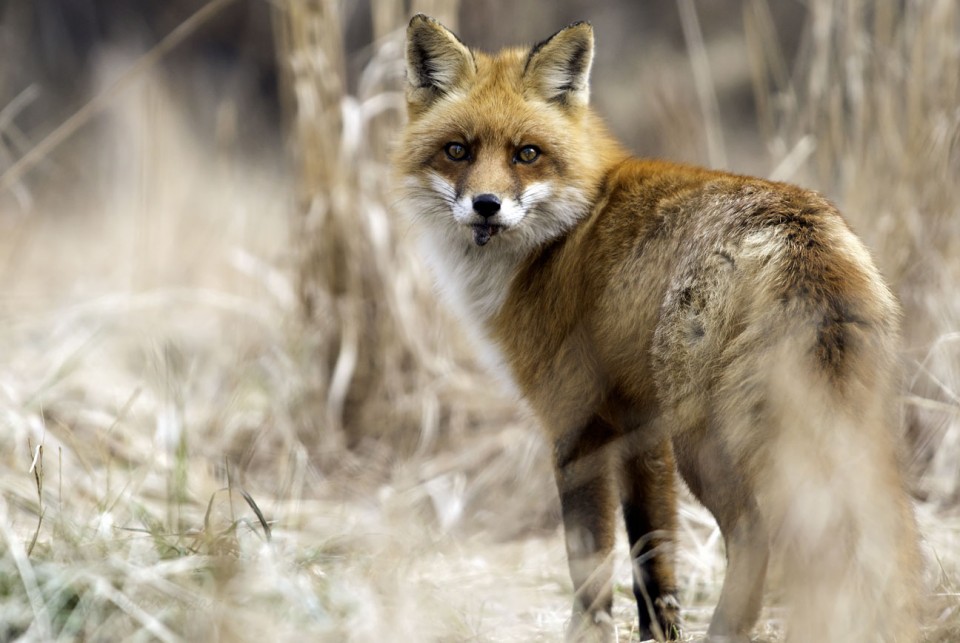
Unfortunately, neither of the above is necessarily a particularly reliable method of estimating diet. Red foxes (Vulpes vulpes) in rural settings, for example, feed heavily on field voles. In a fascinating paper to the journal Mammal Review, Oxford University zoologist David Macdonald documented the food preferences of some hand-reared foxes that he took on walks. Macdonald found that, although foxes often killed bank voles, they very rarely ate them, opting to cache them instead; they only occasionally returned to these caches. By contrast, field voles were either eaten immediately, or carefully cached for later recovery. So, excavating a cache containing bank voles, or scaring a fox away from a kill to investigate the prey could lead to the erroneous conclusion that foxes feed heavily on this vole species. Moreover, foxes tend to eat voles whole, so there are seldom any remains left to find.
There are obvious drawbacks to guessing the prey species from the noises you can hear in the darkness. While one might accurately identify certain prey, such as a hedgehog with its high-pitched "death scream", it is probably impossible to differentiate the crunching of one insect from another. In his contribution to Adrian Middleton and Richard Paget's 1974 book Badgers of Yorkshire and Humberside, Keith Bradbury wrote:
" ... a variety of feeding sounds regale the [badger] watcher. Cracking and crunching noises suggest snails or hard vegetable matter are being consumed, whilst the sounds of sucking suggest to the patient observer that soft material has been discovered. As entertaining as these feeding noises are they lead to no conclusive evidence on the diet."
So, feeding sounds aren't particularly helpful, while direct observation is often painfully difficult and the analysis of feeding remains or caches is potentially both inconclusive and misrepresentative. If we exclude the data obtainable by food preference studies of captive animals and stick with wild individuals, we are left with two options: look at what's in the stomach; or look at what comes out of the digestive tract in the droppings.
The analysis of stomach contents has long been used as a method of telling what an animal has eaten -- after all, if you find the remains of a hedgehog in the stomach of a fox, there can be little doubt that the fox actively consumed it. Under most circumstances, however, in order to get at stomach contents the animal has to be dead; some species, many sharks for example, do lend themselves to live stomach analysis, but most studies are carried out post mortem. Scat, by contrast, can be collected reasonably easily, without interfering with the animal in question. Each method has its advantages and disadvantages.
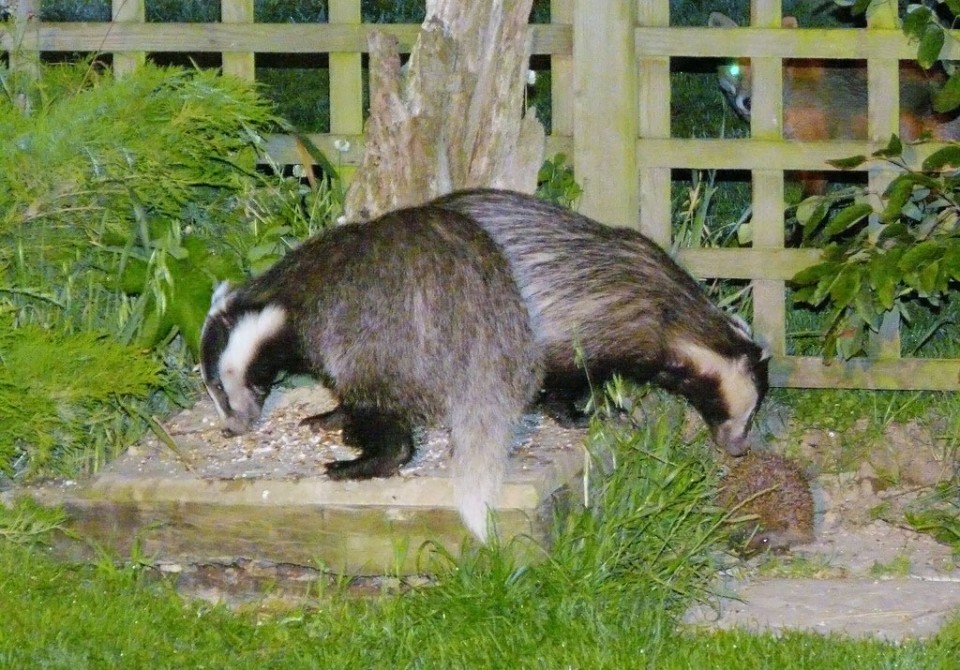
In a short paper to the journal Wildlife Biology during 1995, Italian biologists Paolo Cavallini and Teresa Volpi discussed the potential biases in the analysis of the diet of foxes from both stomach contents and scats. The researchers found that mammal remains were prevalent in the scats, having survived digestion, while invertebrates and vegetable matter were generally only identifiable in gut contents. One interesting finding was that both the volume and frequency of bird remains declined from stomach to intestines and faeces. In other words, bits of bird tended to remain in the gut rather than being excreted, providing the possibility that stomach analyses could overestimate bird consumption, while intestine and scat analysis may underestimate it. The authors suggest that this finding may represent differential passage through the pyloric sphincter, the valve leading from the stomach into the small intestine, causing large fragments of feather to remain in the gut while smaller fragments, which are more easily overlooked, pass into the intestines and ultimately into the faeces.
A further complicating factor is the issue of digestibility. When measuring and reporting dietary preference there are several methods scientists can choose. Researchers might calculate frequency of occurrence (i.e. how many scats a given item was found in), or as a percentage of occurrence (i.e. what percentage this particular item makes up of the total number of different food items found). The problem with both methods is overemphasis of the importance of small prey items -- these may be eaten in large numbers, but actually contribute little to the animal's overall energy budget. Consequently, many biologists calculate the item's frequency as a percentage of the total consumed biomass. In other words, how much the item makes up of the "useful" (i.e. capable of being metabolised to provide energy) stuff consumed. To do this, you need to know how much of the consumed food is metabolised and how much is excreted, but the result is called the digestibility coefficient (DC) and tells us how easy an item is to digest.
In a 2003 paper to Acta Theriologica a team of Portuguese biologists collaborating with Oxford University's WildCRU presented the DC of various prey taken by badgers (Meles meles). The values of rabbits, rodents, pigeons and amphibians were 24.75, 21.72, 19.81 and 99.50 respectively. Unfortunately, this study was conducted on only a single captive badger, which limits the conclusions we can draw. Nonetheless, if representative, the results suggest that if a badger ate a frog, it would digest almost all the tissue (a DC of 99.50 means only 0.50% will pass into the droppings). Ergo, frog remains are very unlikely to turn up in scat analysis. Conversely, the same badger could only digest about 20% of its pigeon meal, with the remaining 80% passing out in the scat.
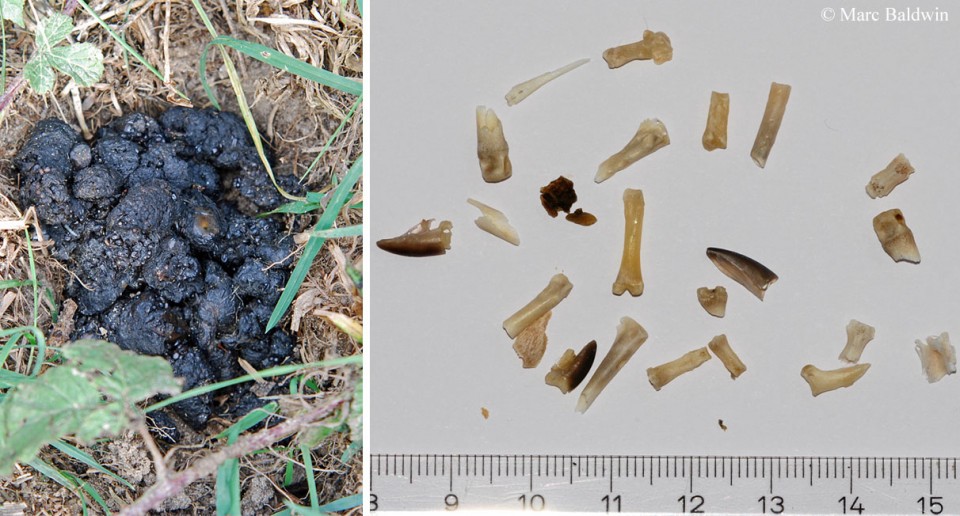
The take home message from the above is that it is difficult to calculate precisely how important, energetically-speaking, a given prey species is to a predator. We use gut analysis, we look at the remains passed out in scats, we offer them different foods while in captivity and we observe the animals in the field. Despite our best efforts, it is still difficult to do more than make an educated guess as to the relative importance of any single prey item. Nonetheless, if all you're interested in is a list of prey items that a predator will eat, looking at the gut and scat is a good starting point.
The fox and the hedgehog
As well as being a very interesting essay by political philosopher Sir Isaiah Berlin about the division of writers and thinkers into those who hold a single defining idea (hedgehogs) and those who draw on multiple experiences (foxes), the above title is also given to several fables. In one such allegory, a fox hungry for a hedgehog meal devises a cunning plot to nab himself some prickly prey. The hedgehog, by contrast, has only one ploy to avoid being eaten: roll into a tight ball, presenting its sharp spines to any would-be attackers. In the story, despite all the fox's clever plans, the hedgehog's simple one saves its life: in other words, simplicity triumphs over complexity.
On a roll
These endearing fables raise an interesting question: how could a fox penetrate the fortress of spines to get at the edible bits of a hedgehog? A fox's claws aren't long enough to reach past the spines and, even if the fox could get a grip, there is insufficient musculature and rotational capacity in their fore legs to force the hedgehog apart. Similarly, a fox would have a tough and probably painful time trying to bite through, or off, the spines. Legend and rumour have credited foxes with several clever ploys to make hedgehogs uncurl; from rolling them into water and attacking as they attempt to swim, to urinating on them and attacking when the hedgehog unrolls to protest. I have heard such stories from several reputable sources and have little doubt that foxes do pee on hedgehogs, although this doesn't necessarily cause them to unroll. In January 2006, the BBC Wildlife Magazine published a letter from a reader who queried this behaviour, writing:
"Last summer, I was watching a hedgehog feeding on my lawn when a fox appeared. It approached the hedgehog and started pushing it with its nose and pawing it with its forefoot. The hedgehog rolled into a ball, but the fox continued to prod it. Finally, it urinated on the hedgehog. My prickly friend stayed rolled up and the fox wandered off."
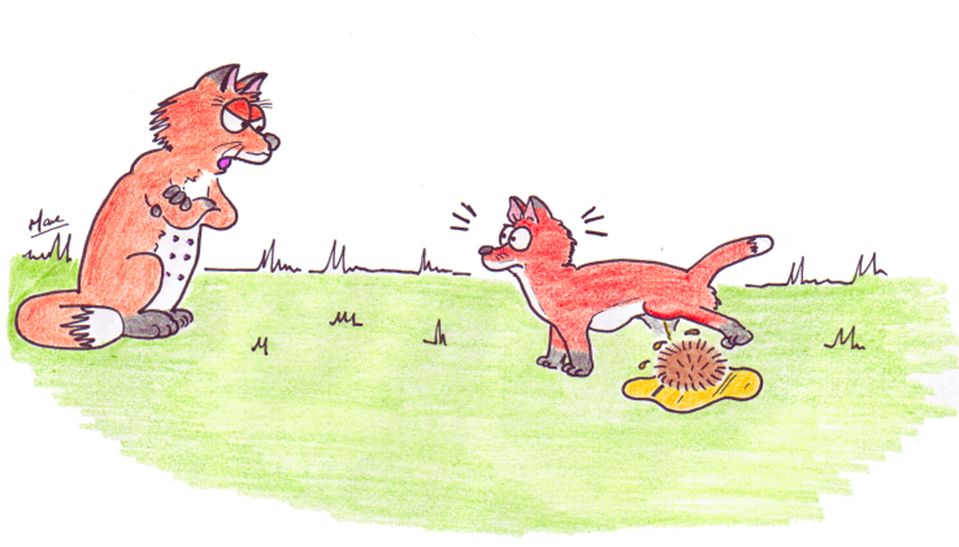
If being drenched in fox urine isn't sufficient to make a hedgehog unroll, why should a fox do it? It's possible that in some cases the hedgehog does uncurl and, to the fox, the potential benefit outweighs the minor loss (of urine), making it "worth a shot". Some authors, however, argue that this behaviour has a far more mundane explanation. In the July 2006 BBC Wildlife Magazine, Bristol University mammologist Steve Harris explained:
"Urinating on hedgehogs to get them to unroll is a myth. ... Since foxes urinate on objects that interest them, it is not surprising that they urinate on rolled up hedgehogs."
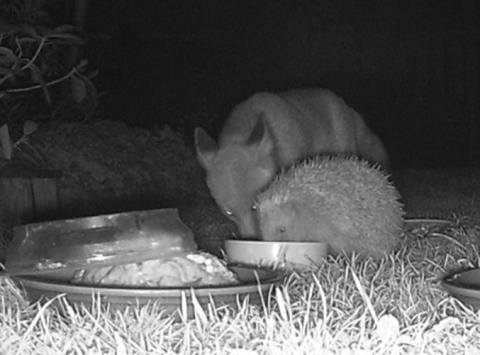
So, urinating on hedgehogs may simply be part of their territory marking behaviour -- on some, perhaps rare, occasions it may also result in a meal. Harris and Phil Baker parallel this view in their book Urban Foxes, and note that foxes trying to take living hedgehogs tend to make repeated bites to the back of the rolled-up animal; they note that such attacks are usually unsuccessful at even getting the hedgehog to unroll, let alone killing it. This is not universal behaviour either, and there are many examples of foxes paying no more than a casual interest in hedgehogs; the two often feed together in the same gardens.
Nonetheless, Polish biologist Jacek Goszczynski described foxes excavating hedgehogs on his study site at Turew in western Poland. In a 1974 paper to the journal Acta Theriologica, Goszczynski wrote:
"In other two cases it was observed that foxes digged [sic] out hedgehogs (Erinaceus europaeus Linnaeus, 1758) from under the snow. The predators consumed only part of the hedgehog head."
Presumably the hedgehogs were either hibernating, in which case this can be considered active predation, or were already dead and the foxes were scavenging their remains. Another example comes from Oxford in the UK where, while tracking the fate of rehabilitated hedgehogs, Patrick Doncaster and his colleagues found that, of the 26 hedgehogs eaten during the study, one was predated by a fox. It should be noted that the event itself wasn't observed, rather inferred based on fox guard hairs on the carcass.

More recently there have been cases where trailcams/CCTV have captured foxes attacking hedgehogs at feeding stations. In particular, I have seen a couple of videos that seem to show a fox snapping at the back legs of a hedgehog and some hedgehog carers have attributed animals with severed legs to fox attacks. In an article in press with the journal British Wildlife, David Element discusses fox predation on both adults and hoglets in south-west London. Element has found several decapitated hoglets in his neighbourhood and heard one attack in a neighbour's garden. David notes that, in his experience, hedgehogs are hardy animals that are well equipped to deal with the loss of a hind leg. In one example, during the early 1990s, he found an adult female hedgehog rolled up with her amputated leg lying nearby and, in the article, explains:
"About 5-10ml of blood had pooled underneath the stump but this was the total quantity of blood shed as the arterial wound had effectively clamped itself shut by muscle spasm. Astonishingly within two hours this female was watched foraging normally as if nothing had happened. On another occasion I examined a young female only to discover that she had only three legs and a neatly healed stump where I had thought that her other hind leg ought to have been. Examination of a photograph taken only five days earlier proved that she had indeed been in possession of a full set beforehand so one must have been bitten off in the interim. The healing process had been extraordinarily rapid!"
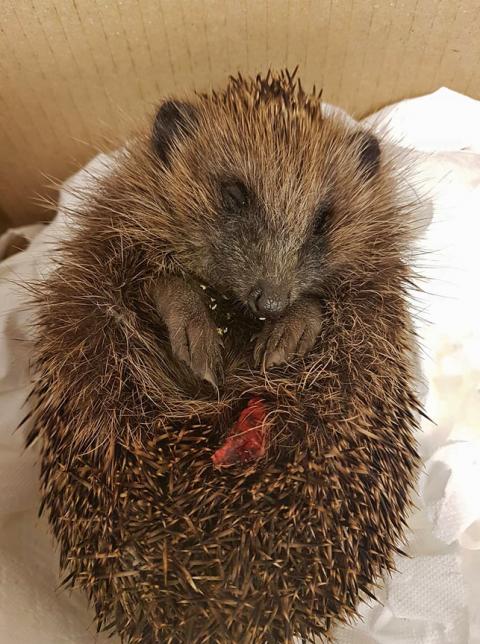
One common theme in David's observations is that the amputated leg does not appear to be eaten. It strikes me that, for the adults, it is their propensity to curl up after an attack that probably makes them vulnerable to amputation. Based on the trailcam videos I've seen of attacks and the descriptions David has provided in the article and via e-mail, it seems reasonable that the fox snatches at whatever it can; this often seems to be a hind leg as the hog runs away or passes. If the fox lifts the hedgehog by its leg, the pressure from the sharp incisors coupled with the weight of the hog would be more than sufficient to amputate the limb. The hedgehog hits the ground and immediately curls up and the fox drops the meat-less leg to investigate the rest of the animal. After a minute or two of sniffing, with the hog showing no signs of uncurling and the fox loses interest and goes about its normal routine. Whether the fox sees the hedgehog as a prey item, or just an object of (unfortunate) curiosity, I do not know.
This seems to be an emerging threat from foxes, although we currently have insufficient data to suggest how frequently instances like this occur. At least one hedgehog carer I know is convinced that such attacks are commonplace and, in his article, David notes that "the back legs of adult hedgehogs are not infrequently amputated by fox-bites". Similarly, at The Day of the Hedgehog conference, organised by the People's Trust for Endangered Species and the British Hedgehog Preservation Society and held in Shropshire during November 2015, Royal Parks biologist Nigel Reeve reported that eight (40%) of the 20 dead hedgehogs that his team found in Regents Park between May 2014 and October 2015 were suspected victims of fox attacks, having suffered leg injuries.
Curiously, my experience, and that many others, suggests that foxes generally show little more than passing curiosity towards hedgehogs and, while they may sniff and prod them, they rarely show any desire to attack them. Does this suggest a localised, learned response?
On the menu
How ever they may break through the armour, there is no doubt that hedgehogs are eaten by foxes. Dietary studies based on both scat and gut analysis confirm that hedgehog remains are sometimes present, although they occur rather rarely; occurrence is typically less than 1% of samples, and usually only 0.2% to 0.3%, which equates to hedgehog remains in two or three out of every 1000 samples. Despite generally low occurrence, some studies have suggested local variations and, in a paper to the Journal of Zoology during 1977, for example, D. F. Richards provided details on the diet (based on scat analysis) of foxes in South Devon. Richards found hedgehog remains during all seasons, with occurrence ranging from 2% during summer to 13% in winter. Dietary studies elsewhere also support a seasonal trend in hedgehog predation. In a short paper to the same journal during 1987, biologists from the University College Dublin report hedgehog remains from 0.9% of fox scats collected during summer on an estate in County Kildare in Ireland; no hedgehog remains were found in scats collected during winter.
In his book Running with the Fox, however, David Macdonald described how he and a colleague found the remains of "a dozen or more hedgehogs, their armoured jackets neatly peeled off and nibbled clean" at an earth in Oxford's Botley Cemetery. Similarly, in Wild Fox: A Complete Study of the Red Fox, Roger Burrows noted how the spines don't stop foxes from opening hedgehogs up. Burrows tells how he found two cleaned-out hedgehog skins during his three-year study of foxes in Kent (UK), although he found no spines in any of the droppings he analysed. We now know, however, that many of Burrows' observations were misinterpreted, and his description sounds much more like the work of a badger (see below) than a fox.
Other authors, by contrast, have considered hedgehogs incidental prey of foxes. In his book Country Foxes, biologist Hugh Kolb noted how "the remains of insectivores such as shrews, moles and hedgehogs are only rarely observed in stomachs and scats, compared with their abundance in the countryside", while Brian Vezey-Fitzgerald, in Town Fox, Country Fox, considered that, while foxes have acquired a great reputation as hedgehog killers, they are often incidental prey, snapped up if the opportunity arises. Similarly, the idea of opportunity appears to be supported by Finnish wildlife biologist Darrell Sequeira's literature review of Red fox diet in Holland, Denmark and Finnish Lapland. Sequeira listed the hedgehog as of "secondary importance" to Dutch foxes, with hedgehog remains absent from scats of Danish and Finnish foxes. In Britain, the suggestion is that remains in scat may also represent scavenged roadkill and, in his New Hedgehog Book, Pat Morris wrote:
"Bits of hedgehog are quite common in the stomachs and droppings of town-dwelling foxes, but most likely this is a result of scavenging squashed carcasses off the roads rather than deliberate killing."
I have found hedgehog remains that I took to have been a left by a fox only once. They were on a private industrial site in Southampton with a known fox population but no evidence of badgers, and I found fox scat next to the remains. This coincided with many dead hedgehogs on the surrounding roads and it seems reasonable that a fox might've collected a casualty from a nearby curb and taken it to this quiet site, fenced and patrolled by 24-hour security, to eat it. The moving and consumption of road traffic kills may also explain the number of hedgehog skins found by David Macdonald in Oxford and, depending on how common this behaviour is, may raise an interesting question for mammal surveys that get their data by counting urban road casualties.
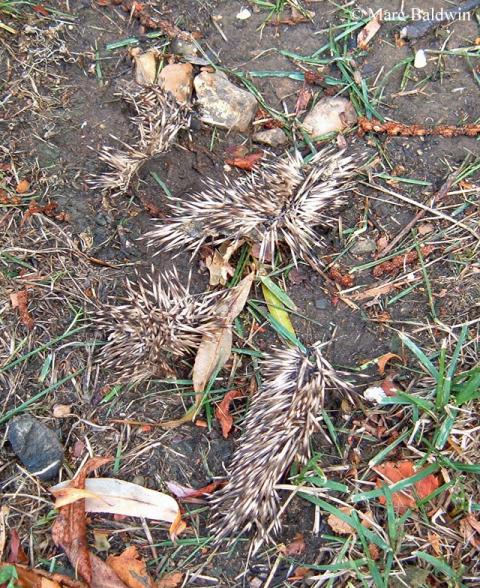
In most cases, dietetic studies make no specific mention of hedgehogs, although some group samples into broad categories such as "wild mammals" or "unidentified remains", which may conceivably include hedgehogs. Overall, the dietary studies suggest that foxes aren't a significant predator of hedgehogs, but digestibility coefficients could be having an impact. Where hedgehog remains have been found in scat samples, they normally take the form of spines. Spines are composed primarily of keratin, which makes them resistant to the digestive enzymes in the guts of most predators, explaining their presence in scat. If the fox ignores the spines and eats only the muscle, skin and bone tissue, it is unlikely that much would make it through to the scat to identify the prey as a hedgehog. To put it another way, hedgehog spines have a relatively low digestibility coefficient, while the coefficient of hedgehog tissue is likely to be much higher. If foxes eat hedgehog tissue in preference to spines, this may explain why hedgehog remains are rarely recorded in scat and stomach analyses.
Some anecdotal evidence suggests that fox and hedgehog populations may be connected, but data are scarce. In their book, Urban Foxes, for example, Steve Harris and Phil Baker comment that hedgehogs seemed to increase when the fox population in Bristol crashed in response to a mange epidemic during the 1990s. At the same time, badger culling programmes aimed at reducing bovine tuberculosis have suggested an increase in hedgehogs and foxes in response to a decline in badgers. It's worth remembering, however, that foxes and hedgehogs are intraguild competitors. In other words, they eat the same sorts of food; namely earthworms and insects. All other things equal, even if foxes themselves aren't a big predator of hedgehogs, fewer foxes means more earthworms to go around. Food is a limiting factor for populations, it controls population growth and decline, so more food can mean more hedgehogs. We call this phenomenon competitive release.
Finally, I've seen some accounts on social media of foxes taking hedgehogs. Several of the comments associated with these examples suggest that "it happens often", and while this may be the case, to the best of my understanding this is an assumption and the true extent of this phenomenon remains unclear. Comments are mixed on the subject of feeding foxes; some implying feeding foxes and hedgehogs together is asking for trouble, while others suggest feeding foxes makes them less likely to predate hedgehogs. Indeed, there is an implication that foxes taking hedgehogs are starving. Again, the data do not exist to confirm one way or another, but I would anticipate that a fox would not need to be on the verge of starvation before predating a hedgehog. Foxes are optimistic predators and will try their luck where they encounter it. There is certainly the potential for supplementary feeding to change the dynamic between the species, but it remains to be seen whether this can have long-term affects on the populations of either. If food is provided for both, I would certainly recommend that it is provided disparately.
So, the picture is complex and the jury is still out on how much of a threat foxes pose to hedgehogs. Based on current data, it seems that they are probably more significant than we previously thought, but more work is needed.
Badgers, badgers everywhere…
Looking purely at the dietary studies you could be forgiven for thinking that badgers had only a slightly greater impact on hedgehogs than foxes. Many studies of badger droppings make no mention of hedgehogs and those that do usually report hedgehog remains in fewer than 10% of faeces. In Badgers of Yorkshire and Humberside, Keith Bradbury noted that he found hedgehog remains in only three of the nearly 800 (about 0.4%) faecal samples that he analysed, explaining:
"This paucity of records for hedgehog remains in the dung, seems to imply that badgers eat them reluctantly, or that only certain individuals develop the necessary skill for dealing with them..."
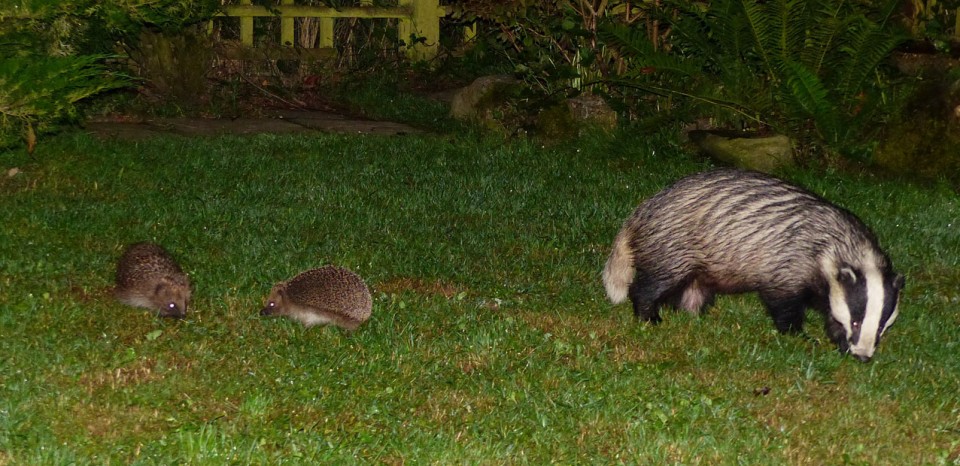
Here Bradbury is referring to all remains having been found in the same area, with two samples from the same sett. As with foxes, however, remember that scat is the end-product of digestion and only contains the bits that are resistant to digestion; the fur, teeth, bones, etc. We need, therefore, to consider which parts of the hedgehog a badger will eat.
In a short note to the Journal of Animal Ecology, Adrian Middleton described the stomach contents of an adult male badger hit by a car in Oxford during July 1935. From remains of feet, fur and spines Middleton and his colleague concluded that at least four different hedgehogs had been eaten and wrote that:
"The badger seemed to have exercised considerable skill in taking only the inside edible portions of the hedgehogs, as only three or four spines were found in the stomach."
The remains that Middleton described, bar the couple of spines, would almost certainly have made identification of hedgehog prey from the badger's scats all but impossible. Similar observations from the field suggest that badgers almost never eat the skin and spines. Indeed, in their book Badgers, Ernest Neal and Chris Cheeseman quote a rather gruesome extract from naturalist Christine Ferris' diary, in which she described how a badger family (a boar, sow and three cubs) stumbled across a female hedgehog with four hoglets. The sow and cubs ate the hoglets, while the boar concentrated on the adult. According to Ferris, the badger rolled the hedgehog on its back and pushed its claws into the join where the head curls into the body, at which point it pulled the hedgehog open, belly-up, and pinned it at either end. When Ferris returned to the scene the following morning, she found the skin picked clean, except for a small part of the head. Neal and Cheeseman go on to quote another similar example, where only the skin remained after the attack; no trace of viscera or blood was found.
The observations presented by Neal and Cheeseman are supported by various studies tracking the fortunes of rehabilitated and translocated hedgehogs, which frequently report losses to badgers. In such cases, the presence of hair on the carcasses and/or finding a skin picked clean is taken as evidence of the culprit having been a badger.
In May 2006, I asked Oxford University biologist Chris Newman whether they had any hedgehogs in Wytham Woods, a woodland estate owned by the university in Oxford that had a badger population of about 250-300 animals at the time, and his answer was succinct: "No. The badgers eat them all." Pat Morris also seems in little doubt that badgers represent a significant threat to hedgehogs and, in his New Hedgehog Book, he wrote of how not only do they have the long claws and powerful musculature needed to "break into" a hedgehog, the two species also compete for earthworms.
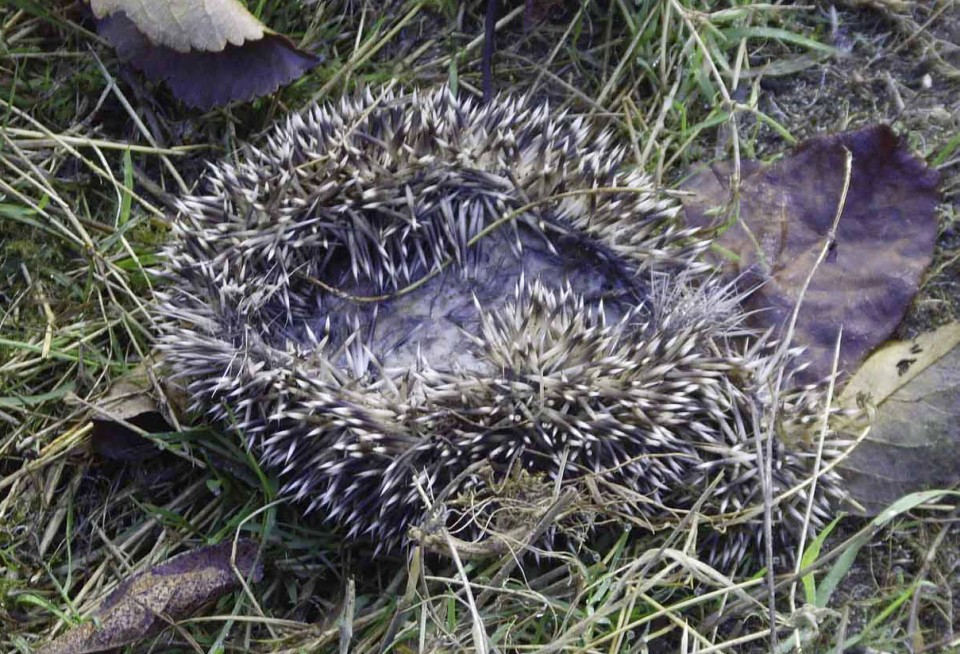
Morris estimated that a single badger can, in a single night, eat the same number of worms as seven hedgehogs and considered that predation and competition combined must spell bad news for hedgehogs; that, quite simply, more badgers must equal fewer hedgehogs. In his book, Morris suggests that the roughly 10% increase in Britain's badger population between 1990 and 2004 probably resulted in some 100,000 fewer hedgehogs, although he is careful to point out that he doesn't blame the badgers; "it's just what they do", he wrote.
A different perspective
Rather than looking for hedgehog remains in badger latrines, some scientists decided to look at how hedgehogs react to badgers. It has long been known that the risk of being on someone else's menu is a key factor governing an animal's activity patterns. For some 20 years now, we have known that predation risk influences how long Grey squirrels (Sciurus carolinensis) stay at a feeding site, for example, and how they handle the food they eat. Squirrels were found to eat their food more quickly the further they are from cover, and thus the more vulnerable they are to attack, as well as choosing less nutritious foods because these could be carried away to be eaten in a safer spot. Similarly, we know that prey species are pretty quick to respond to the odour of potential predators. Studies on captive rabbits (Oryctolagus cuniculus) have shown that they become much more vigilant when exposed to fox odour, while rainforest rodents in Australia were shown to avoid feeding stations tainted with predator faeces, but weren't phased by the stations contaminated with herbivore scent.
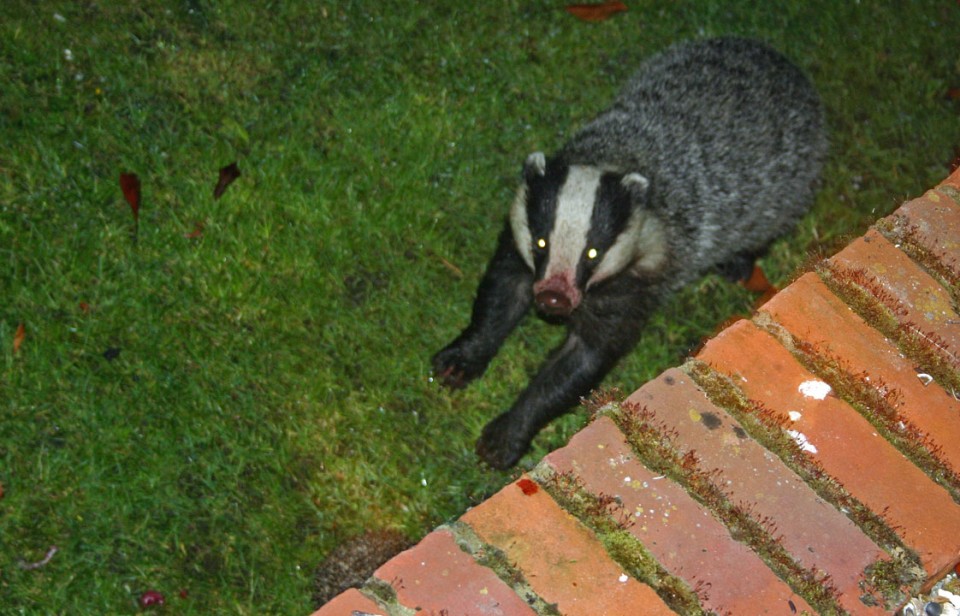
In 1991, Patrick Doncaster set about testing whether the presence of badgers affected the behaviour or distribution of hedgehogs. In May of that year, Doncaster released 50 adult hedgehogs equipped with radio-transmitters into two sites in Oxfordshire with different badger densities: Wytham Woods which has some 20 badgers per sq-km; and Eynsham Park with only about two badgers per sq-km. Doncaster monitored the hedgehogs' movements and fate. Twelve of the hedgehogs released into Wytham died, seven killed by badgers. Two hogs from Eynsham were killed, one by a fall and the was runover.
By the end of the study, only three (10%) of the 30 hedgehogs released into Wytham remained in the wooded area around the release site, compared with 13 (65%) of the 20 released at Eynsham. Moreover, during the study, the Wytham hedgehogs were observed to disperse twice as far from the release point as those released into Eynsham. In short, Doncaster watched the hedgehogs move out of the woods and into nearby urban gardens. Given that the habitat was very similar at both release sites, the conclusion was that the hedgehogs were moving away from the badgers of Wytham. In his 1992 paper to the Proceedings of the Royal Society of London, Doncaster wrote:
" ... the higher density of badgers at Wytham appeared to be the crucial difference giving rise to the observed increases of mortality and dispersal ... Badgers may be able to exclude hedgehogs from Wytham because they are sustained at high densities by alternative invertebrate prey ... "
A subsequent study by the same author monitored hedgehog populations at three sites in Oxford over six months in 1992 as they were increased or decreased by translocation. The study found that badgers were the main predator, although one hog was eaten by a fox. At one site in particular, Ditchley, badger numbers were high enough to suppress the hedgehog population, keeping it lower than nearby sites with fewer badgers. The hedgehogs released at Ditchley that survived were observed to stick closer to residential buildings, which were avoided by the badgers -- this is what ecologists refer to as enemy-free space.
A similar study conducted by Doncaster, Carlo Rondinini and Paul Johnson during 1994 yielded very similar results; hedgehogs were tracked moving substantially further and faster from unfavourable (high badger) sites than from more favourable (low badger) ones, and there was a strong tendency for the hedgehogs to settle in urban areas, rather than arable habitats. The authors suggested that the movement towards urban areas occurred because these were unoccupied by badgers. At this point it should be noted that many of Britain's agricultural landscapes appear to be becoming unsuitable for hedgehogs and more recent tracking data have shown that hedgehogs generally seem to actively avoid arable areas, badgers or no badgers.
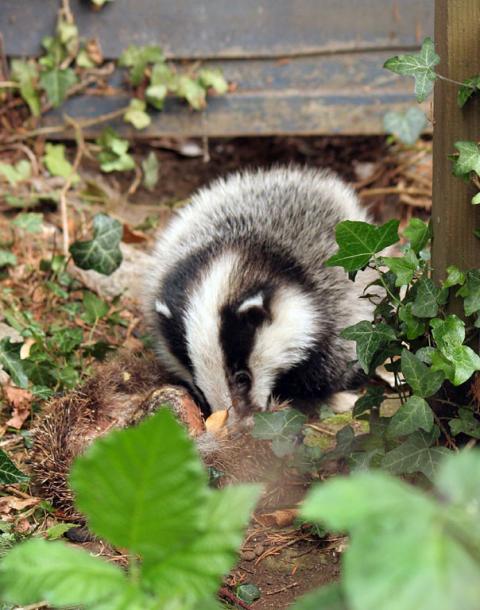
Thus far, we have seen data from Oxford, but is this picture representative? More recently, a joint study by researchers at the Central Science Laboratory in York and Southampton University looked at hedgehog density and distribution at ten sites in the Midlands and south-west England. The researchers, led by Richard Young at the CSL, found that hedgehogs were generally to be found in urban gardens and parklands; they were rare in pasture fields. Moreover, the biologists observed that as the number of badger setts in an area increased, the likelihood of finding hedgehogs there decreased; this relationship was a linear one, with hedgehogs apparently excluded altogether from some areas with very high badger densities.
Young and his team also found that it was the number of badger setts in a two kilometre (~ 1.5 mi.) area around their parkland study sites that seemed to affect whether, and how many, hedgehogs were present; the local larger scale badger sett density and distance to the nearest badger activity (e.g. foraging) had little effect. The authors suggested that hedgehogs experience high predation pressure -- i.e. a good chance of being eaten -- at high badger densities, and this may prevent or severely limit hedgehog movement between suburban patches. Without this movement, numbers can't be replenished as animals die and populations shrink. Hugh Warwick notes the same thing in an article to the December 2016 issue of British Wildlife in which he wrote that:
"Badgers fragment the landscape, restricting the ability of Hedgehogs to move freely".
Interestingly, the CSL study also found that the average growth rates for hedgehogs were similar in areas of high and low badger density, suggesting that the exclusion of hedgehogs by badgers is predatory rather than competitive. In other words, hedgehog numbers fell because they either avoided, or were eaten by, the badgers, rather than starving to death because badgers ate all the food. Working in north-eastern France, Pauline Hubert and her colleagues found that badger predation could have an impact on the survival of young hedgehogs, recording a reduced reproductive rate with increasing proximity to badger setts.
More recently, in a paper to the journal Wildlife Biology published in 2015, a team of researchers led by Jeike van de Poel at Wageningen University in the Netherlands presented the results of their survey of hedgehog and badger presence carried out between 2007 and 2010. The researchers subjected the survey data to a statistical technique called a species distribution model and found that hedgehog distribution could be more accurately predicted if the distribution of badgers was taken into consideration. The data show that badgers were less likely to be found in urban areas, recreational areas and near roads in the Netherlands, and these were exactly the places where hedgehogs were most likely to be found. van de Poel and his colleagues found that, overall, badgers had a small negative effect on hedgehog distribution and concluded that badgers may force hedgehogs close to human occupation in the Netherlands. Interestingly, however, they also observed that the amount of vegetation cover on arable land positively affected both badgers and hedgehogs. This suggests that habitat structure can play a role in potentially mitigating the impact of badgers on the hedgehog population.
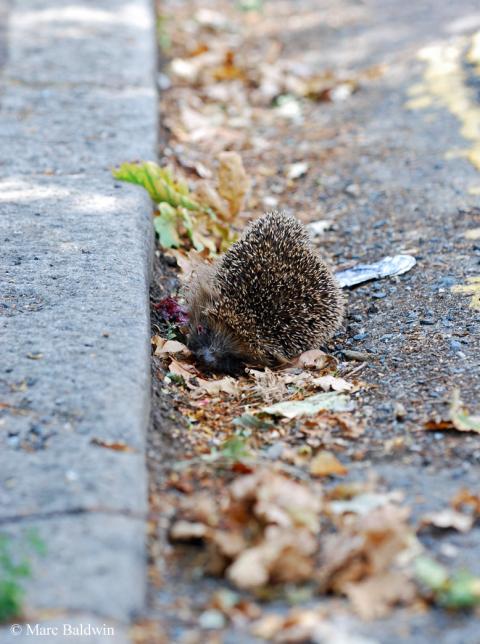
The above studies seem to aptly demonstrate that hedgehogs and badgers don't make good neighbours. It is worth pointing out, however, that not all studies have drawn the same conclusion. Indeed, Young and his colleagues failed to find a link between badger activity (i.e. foraging) and hedgehog occurrence, which suggests that the hedgehogs didn't avoid the playing fields where badgers were also hunting. Similarly, in a 1993 paper to the journal Revue d'Ecologie: La Terre et la Vie, Patrick Doncaster wrote:
"Free-ranging wild hedgehogs (Erinaceus europaeus) radio-tracked in Oxfordshire showed no such response to predators. They foraged singly on exposed pasture with a random distribution of distances from cover, and yet they suffered significant mortality due to predation by badgers (Meles meles)."
During their French study, Hubert and her colleagues found that hedgehog abundance was predicted by food availability (earthworms and pet food) and not by badgers, while, in Ireland, Amy Haigh and her co-workers observed hedgehogs and badgers foraging for earthworms in the same pastures and, in their paper to the journal Mammalia in 2012, they note:
"Hedgehogs foraged freely in the centre of the fields showing no signs of predator avoidance."
At the end of his 1992 Proceedings paper, Doncaster suggested that, while we don't know how the hedgehogs caught on to the notion that there were badgers in the area "they are likely to have been guided by their keen sense of smell". It is smell that was to feature in another series of experiments, designed to test what impact badger odour had on hedgehogs.
The nose knows
During the early 1990s, a joint team from Oxford University and the Chizé Centre for Biological Studies in France investigated the response of hedgehogs to predator odours. The team, led by WildCRU biologist Jane Ward, caught five wild hedgehogs from farmland around the village of Villiers-en-Bois in western France and put them, and 10 long-term captive individuals, into a respiratory chamber so they could monitor their oxygen intake as a measure of stress and general alertness. The hedgehogs were then exposed to a predator odour (badger faeces) and a non-predator odour (roe deer, Capreolus capreolus, faeces).
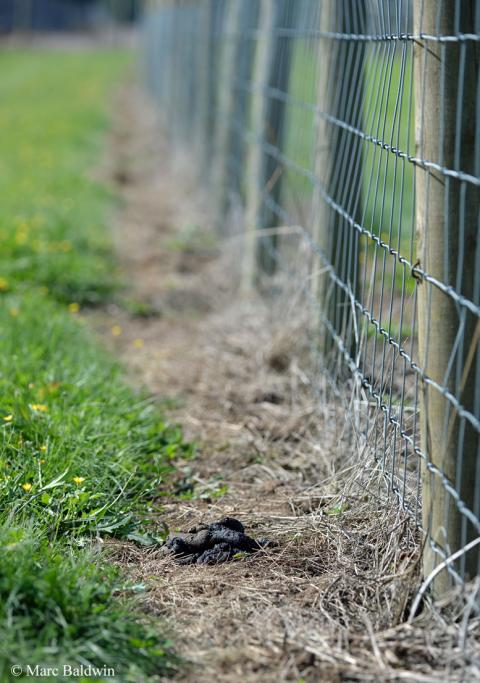
Ward and her team found that the long-term captive hedgehogs showed no response to either the faecal solutions. The recently-caught animals, by contrast, increased their oxygen intake by just over 21% when exposed to badger odour, and just over 1% when exposed to deer faeces. Twenty-one percent isn't a huge increase in oxygen intake when compared to, say, running; but it does suggest that the hedgehogs could distinguish between the two odours, and recognised a potential threat. Indeed, having accounted for movement around the enclosure, the biologists concluded that the increase in oxygen uptake was an indication that the hedgehogs were more alert to the possibility of danger when exposed to badger scent.
Obviously, Ward and her team were careful about drawing conclusions from such a small data set, but their study did present two very interesting suggestions worthy of further study: wild hedgehogs clearly seem capable of responding to predator odour at low concentrations (1:1000); and hedgehogs held in captivity for long periods might "unlearn" their response to predator odour, which may pose problems upon release.
A complementary study published in the journal Animal Behaviour during 1997 saw three of the same authors (Ward, Macdonald and Doncaster) comparing the response of captive hedgehogs to free-ranging animals from a badger-free golf course and surrounding playing fields in Oxford city. The hedgehogs were exposed to several odours to gauge their response. Unfamiliar non-predator odours took the form of Siberian chipmunk (Eutamias sibiricus) faeces and guano from Indian fruit bats (Pteropodidae giganteus), while badger faeces provided the predator odour.
The scientists found that the response of captive hedgehogs differed from the individuals they tested in the field. Hedgehogs in the enclosure ate significantly more from the "safe" (chipmunk) stations than from the "unsafe" (badger) station. Hedgehogs in the field reduced their feeding time by 97% when exposed to the badger odour, compared with 50% when confronted with fruit bat faeces. The wild hedgehogs also moved around and sniffed more when badger odour was present. More interestingly, captive hedgehogs continued to avoid the feeder tainted with badger odour for the following two days.
Despite reducing their foraging activity, often adopting a "fringe down" posture or seeking cover, for periods of up to 30 minutes when presented with badger odour, there was no evidence to suggest that the free-ranging hedgehogs avoided the site over a 24-hour period. The authors speculate that captive hedgehogs may show more prolonged avoidance because they can afford to: they have food on-tap and the safety of a cage. Conversely, free-ranging hedgehogs can't afford to give up a good feeding site for prolonged periods; they just avoid the immediate area or are more alert for a short period, during which time the danger will hopefully pass.
These studies on the effects of odour on foraging behaviour raise the interesting question of whether prey species respond to the odours of individual predators, or whether there is a generic component of all predator odours that they tune into. In a bid to prevent this section from becoming interminable, I shall not pursue the subject here. Sufficed to say that we're still not sure what it is about badger odour that rings alarm bells for free-ranging hedgehogs and why the response might be dampened after a prolonged period of captivity.
So, regardless of whether hedgehogs actively avoid the badgers themselves, the results of these studies tell us that -- in parts of Oxford, the Midlands and south-west England at least -- badgers seem not only capable of impacting hedgehog numbers, but also of influencing hedgehog movements and distribution. The result is that hedgehogs move away from the pastureland on which badgers forage into gardens and parks that badgers less frequently visit. As Hugh Warwick puts it in his recent British Wildlife article, referencing a study by Anouschka Hof and colleagues published in 2012:
"... Badgers create a 'landscape of fear', forcing Hedgehogs to spend disproportionately more time either very close to hedges or within villages."
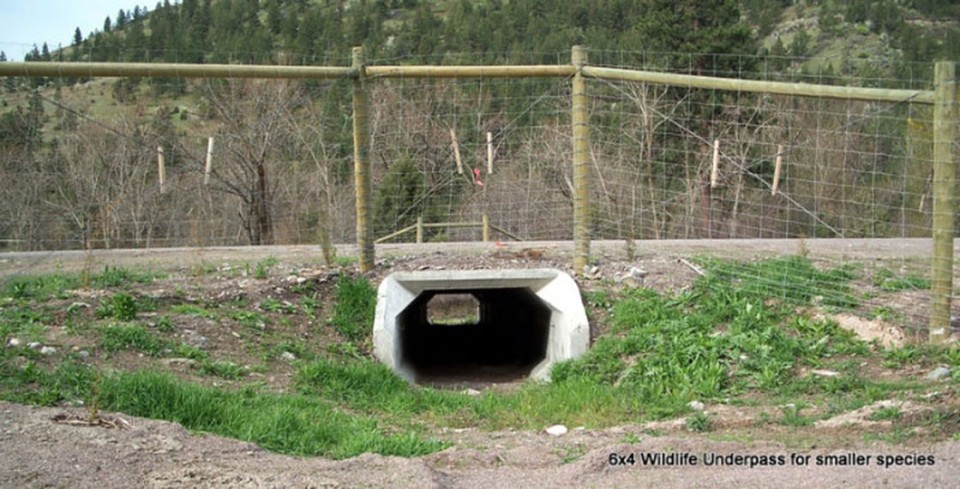
Doncaster also suggests that this deterrence might impact attempts to reduce hedgehog road kill by wildlife constructing underpasses if those tunnels are also used by badgers. We know tunnels are used by both badgers and hedgehogs in Denmark, but in a paper to the journal Lutra in 1999, Donacster suggests that the abundant evidence that hedgehogs actively avoid badgers and the areas they frequent makes it "likely that hedgehogs will avoid using tunnels under highways if they are frequented by badgers."
At this point, it should be emphasized that badgers are invariably only one reason for an apparent shift in hedgehogs to urban areas; changes to farming practices are widely considered to have also resulted in much, particularly arable, farmland being unsuitable for hedgehogs.
Too much of a good thing?
Naturalists have long had anecdotal evidence to suggest that badgers and hedgehogs do not make good neighbours. Indeed, in 1917, one G.H. Pentland wrote to the Irish Naturalist journal noting how:
"About fifteen years ago Badgers appeared in my woods and soon formed a flourishing colony. As they increased, the Hedgehogs, which were then very plentiful gradually disappeared. For five or six years I never saw one at all. Then something happened to the Badgers. Their numbers dwindled till the tribe was reduced to one or two and they seem on the verge of extinction and the little Hedgehogs are reappearing ! Cause and effect evidently."
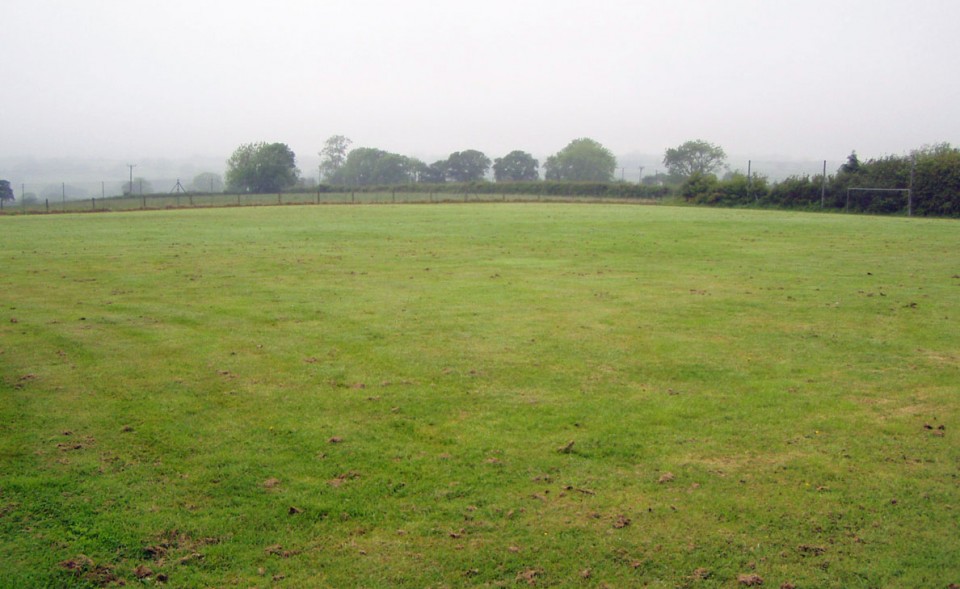
This remains a source of conflict a century later because both species are still widely appreciated by the British public. In 2013, the BBC Wildlife Magazine launched a survey to find Britain's "national species" -- just over 9,100 people voted and the hedgehog came in first, with 42% of the votes, the badger taking second place with 24% of the votes. This suggests it's unlikely that Britons would tolerate the loss of either species from our countryside and has raised the question of what the critical badger densities are. In other words, do we know how many badgers is too many for hedgehogs to survive in the area?
Between June 1991 and August 1992, a team of biologists led by Thierry Micol at the Chizé Centre for Biological Studies looked at pasture fields and grass playing fields around Oxford city in order to gauge the badger density and distribution as well as the presence or absence of hedgehogs. Micol and his team discovered that the abundance of hedgehogs varied with the density of badger setts -- the more setts, the fewer hedgehogs. The principal conclusion of the study was that hedgehogs were almost entirely absent from sites with 2.27 or more badger setts per 10 sq-km (~4 sq-mi.). The team also found that hedgehogs were significantly more abundant on urban playing fields, averaging four per field, than in pasture fields that averaged less than one per field. In their 1994 paper to the Journal of Animal Ecology, Micol and his co-workers concluded that:
"... local variations in the abundance of hedgehogs can be related to the distribution of a principal predators [badgers] and a major food resource [earthworms], and that isolation from neighbouring populations explains the absence of hedgehogs from a small proportion of sites which are otherwise suitable."
The decision to cull badgers in response to a growing problem of bovine tuberculosis in Britain has provided some data suggesting that, as Morris predicted, fewer badgers can mean more hedgehogs. The Randomised Badger Culling Trial (RBCT) established 10 triplets of 100 sq-km (40 sq-mi.) areas in which badgers were proactively culled (i.e. shot before any TB outbreaks occurred), reactively culled (shot when outbreaks occurred) or left alone (no culling). National Wildlife Management Centre biologist Iain Trewby and eight colleagues analysed the data from four triplets alongside surveys of hedgehog abundance. In a paper to the journal PLOS One during 2014, the researchers reported that hedgehog abundance doubled from 0.9 animals per hectare to 2.4 per hectare over the five years the trial ran -- i.e., an increase from about 235 hogs per sq-mile to 560 per sq-mile. Hedgehog abundance did not change in the areas without culling, remaining at about 0.3 per hectare (76 per sq-mile).
It might be argued that these data in fact show hedgehogs moving about more, or being more visible in the presence of badgers, rather than a direct effect of predation; but a parallel tracking study running in one of the triplets at the same time found no change in hedgehog ranging behaviour in response to the culling. The analysis of the RBCT data by Trewby and his colleagues might suggest that reductions in badger populations is a good thing for hedgehogs, and this was certainly the interpretation of some farming bodies.
In an earlier study using the same RBCT data set, however, the same team, this time including Martyn Gorman at Aberdeen University, found that culling badgers increased fox populations. In a 2008 paper to Biology Letters, the researchers reported that, over the course of the culling trial, fox numbers increased by up to 2.3 animals per sq-km -- i.e., an additional 6 foxes per sq-mile. It is interesting to note, therefore, that both hedgehogs and foxes increased as badger numbers declined, lending weight to previous suggestions that badgers have a greater potential to impact hedgehog populations than foxes do.
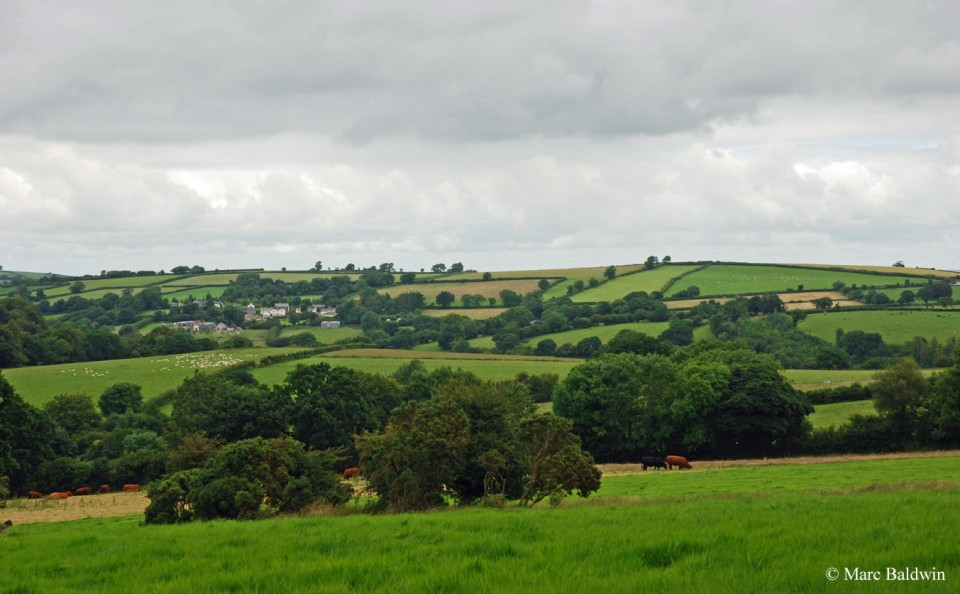
This subject is a very interesting one and serves to remind us that nature is full of intricate connections. It may well be that by protecting one species, we have inadvertently caused more problems for another. More work needs to be done to establish how representative these data are and whether, as Farming Unions have suggested, culling badgers would affect country-wide hedgehog numbers or distribution, or whether current arable farming practices have tipped the balance. Certainly, the data from citizen science surveys such as Living with Mammals have shown hedgehog numbers declining in areas with and without resident badger populations. One thing's for certain: predation by badgers and foxes is just one of a hedgehog's problems. This is a stance echoed by the British Hedgehog Preservation Society and Peoples' Trust for Endangered Species, the latter of who say this, in their position statement on badgers and hedgehogs:
"An analysis of the original badger culling experiments, published in April 2014, shows that, at some sites, hedgehog numbers did increase following reduction in the number of badgers. This is not unexpected, considering what we know of the relationship between hedgehogs and badgers. BHPS and PTES do not consider this sufficient evidence to advocate culling badgers as a means of increasing hedgehog numbers, and believe that culling any species in an effort to conserve another is undesirable given better environmental approaches."